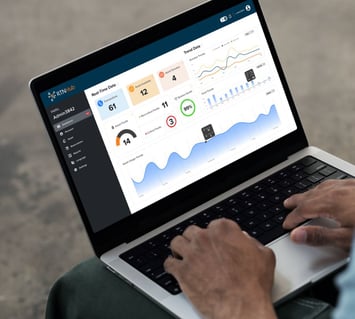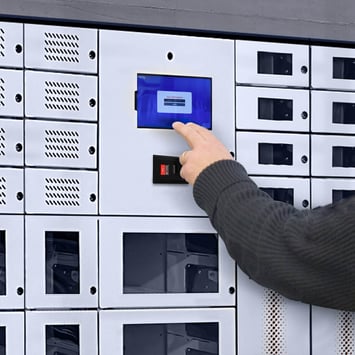By Jay Palter | June 6, 2024
Many organizations are using the monitoring capabilities available in advanced, new access control systems to turn their facilities into smart spaces. Typically, such programs only focus on managing access to larger physical spaces like server rooms, warehouses, or entire corporate campuses.
- What are smart spaces?
- Enhancing business management and security with micro-space control
- Practical applications of smart lockers and other integrated micro-spaces
- Benefits of integrating smart lockers with access control
- Overcoming challenges in implementing smart spaces
- Future-proofing smart security infrastructure
However, integrating smart storage lockers with access control systems can revolutionize how we think about and implement security in smart workplaces. By extending access control to “micro-spaces,” such as individual electronic locker compartments, we can achieve a new level of granularity in asset security management.
This article explores how smart spaces work, how we can extend the concept to managing what we call micro-spaces, and how this mode of thinking has the potential to benefit a wide range of different industries.
Learn More: Ultimate Guide to Smart Lockers
What are smart spaces?
A smart space is any physical area or enclosure holding valuable assets that require a high level of security or management provided by a networked access control system. The access control system tracks and manages the space's use. It provides data for reports or analytics to human operators to aid in decision-making about the space and its housed assets.
Some key characteristics of many smart spaces include:
- Smaller size — Typically, smart spaces are compact for more reliable control and often do not have people moving through them regularly.
- Connectivity — Smart spaces are usually highly connected to corporate networks, Wi-Fi, or cellular networks. This could be through the access control system or directly to networked assets within the space.
- Independent access control — Organizations typically manage access to smart spaces separately through an independent access control system or a dedicated segment of their wider system.
Smart space examples
Dark data centers
Dark data centers are facilities that operate without human presence for extended periods. This requires secure access to protect sensitive data-carrying devices. Within these centers, individual cabinets are secure workplace storage units that house critical IT hardware.
Edge data centers
These are considered a subset of dark data centers. Edge data centers are small-scale facilities located in remote areas. They provide regional network management for infrastructure at the ‘edge’ of larger corporate networks and Internet backbone service providers. Because they’re typically isolated, they have limited access to internal corporate networks, often necessitating stand-alone authentication systems.
Learn More: Data Center Security Best Practices: Safeguarding Your Digital Assets
Biomedical high-security storage
In the medical field, secure storage units for pharmaceuticals and medical supplies, known as medical storage units, are equipped with climate control and access tracking to ensure compliance and safety. Similarly, laboratory storage areas are designed to hold sensitive research materials, chemicals, or biological samples. These materials often require strict access controls and monitoring to maintain security and compliance.
Learn More: A Comprehensive Guide to Pharmaceutical Security
Campus and corporate facilities
Secure meeting rooms in campus and corporate settings offer a restricted space for confidential decision-making. They are equipped with advanced security and monitoring systems to ensure privacy and control over all personnel coming and going and any high-security assets that must remain within.
Learn More: Enhancing Campus Safety with Smart Security Systems
Enhancing business management and security with micro-space control
Integrating smaller-scale physical storage systems with access control expands your organization's reach to a much more granular level. By individualizing control over individual electronic locker compartments, you create smart micro-spaces to finely control access and generate insights from collected transaction and usage data.
Smart micro-space example
Smart lockers
High-security storage units, such as electronic locker systems, protect valuable items like electronic devices, workplace technology, firearms, biological materials, medication, physical keys, and other sensitive assets. Electronic lockers are often equipped with biometric access controls for enhanced security.
Practical applications of smart lockers and other integrated micro-spaces
The integration of electronic lockers with access control systems can be beneficial in various settings, including:
Secure storage for laptops, other mobile electronics, sensitive documents, IT equipment, fleet keys, and personal valuables.
Discover: Corporate IT asset management systems
Controlled access to evidence lockers, weapon storage, and police gear.
Secure storage for laptops, other mobile electronics, sensitive documents, IT equipment, fleet keys, and personal valuables.
Controlled access to evidence lockers, weapon storage, and police gear.
Discover: Key & asset management solutions for K-12 schools, colleges, and universities
Centralized tracking of handheld devices and headsets to ensure they are charged and available for each shift change.
Discover: Smart storage lockers and key management systems for warehouse and distribution centers
Make your workplace smarter with AssetTracer and KeyTracer
Get the peace of mind that comes from knowing your most important assets and keys are always safe and accounted for.
Discover:
Benefits of integrating smart lockers with access control
Integrating smart lockers with access control systems offers a range of benefits, including enhanced operational efficiency and security. Businesses can significantly reduce costs, enhance security, and improve user experience by connecting these systems to a single management platform.
Here are some specific benefits organizations can expect from creating managed smart spaces and micro-spaces.
Reduced operating costs and administrative overhead
Integrating access control systems and physical asset management systems—like smart lockers—can cut operational costs significantly by streamlining processes, improving efficiency, and reducing the need for manual oversight. This integration allows seamless user privileges and asset access management within a single system. User and asset assignments can be handled entirely within the access control system, with asset assignments automatically configured based on the user's job type, department, or special assignment privileges.

Improved security
Managing access and asset storage separately can quickly lead to inconsistencies among record systems. Integration ensures a Single Source of Truth (SSoT), meaning users will lose access to all connected assets and spaces immediately when administrators change their central access control system privileges.

Detailed audit trails
Every interaction with an electronic locker is logged and monitored, creating a comprehensive audit trail. This documentation includes who accessed which locker, when, and for how long, enhancing accountability and tracking the movement and handling of sensitive items.

Enhanced insights
Integration of physical asset management systems allows for the rapid collection of logged events, such as overdue asset alerts, improper returns, or tamper alerts. This combined information provides invaluable insights for administrators to analyze user behavior, offering a more comprehensive view than separate systems could provide.

Streamlined user authentication and experience
An integrated access system provides a seamless experience for users who no longer need to remember multiple credentials or go through multiple steps to gain access. Data sharing between systems allows users to use the same credentials for facility doors and micro-space access, simplifying the onboarding process and improving overall efficiency.

Improved scalability
Integrating access control for smart spaces and physical asset management for micro-spaces allows businesses to scale quickly. New users can be added or removed to their respective departments or job positions, with access assignments made rapidly without manual configuration needed each time someone leaves or joins the organization.

Learn More: Corporate Security: What an Integrated Access Control System Can Do?
Overcoming challenges in implementing smart spaces
Smart lockers can improve your asset management program in several ways.
Upfront installation costs
There’s no way around it. Installing smart lockers involves upfront hardware, software, and integration costs. Despite the initial investment, the long-term benefits and efficiency gains significantly outweigh these preliminary costs, making the investment worthwhile.
User education
To fully capitalize on the advantages of electronic lockers, leadership needs to educate users on the system’s features and functionalities. Clear communication and comprehensive user training are essential for smoother adoption and effective usage.
Maintenance and upkeep
Regular maintenance and software updates are crucial to ensuring the optimal functioning of smart lockers. Establishing a maintenance routine and having reliable support systems in place is essential for the lockers' sustained performance and longevity.
Future-proofing smart security infrastructure
As security threats evolve and become more sophisticated, integrating smart lockers with access control systems offers a proactive approach to protecting smart spaces and micro-spaces. Organizations can significantly enhance their security, improve operational efficiency, and ensure compliance with regulatory requirements by extending access control to micro-spaces, like smart locker compartments.
Take a Step Forward:
Implement an Integrated Physical Access and Asset Control System
Subscribe to our blog

Jay Palter
Vice President of Marketing & Partnerships




